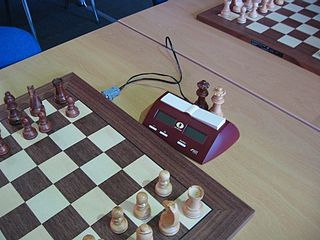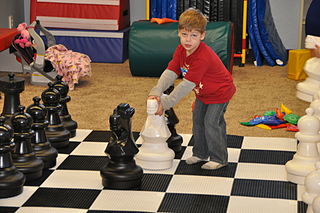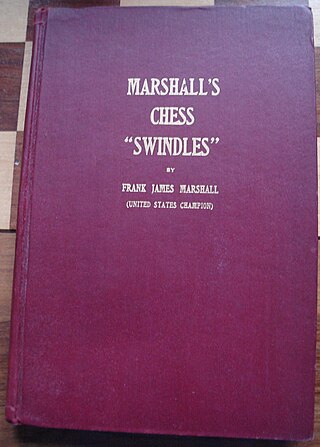Castling is a move in chess. It consists of moving the king two squares toward a rook on the same rank and then moving the rook to the square that the king passed over. Castling is permitted only if neither the king nor the rook has previously moved; the squares between the king and the rook are vacant; and the king does not leave, cross over, or finish on a square attacked by an enemy piece. Castling is the only move in chess in which two pieces are moved at once.
Zugzwang is a situation found in chess and other turn-based games wherein one player is put at a disadvantage because of their obligation to make a move; a player is said to be "in zugzwang" when any legal move will worsen their position.
In chess, there are a number of ways that a game can end in a draw, neither player winning. Draws are codified by various rules of chess including stalemate, threefold repetition, and the fifty-move rule. Under the standard FIDE rules, a draw also occurs in a dead position, most commonly when neither player has sufficient material to checkmate the opponent.
Stalemate is a situation in chess where the player whose turn it is to move is not in check and has no legal move. Stalemate results in a draw. During the endgame, stalemate is a resource that can enable the player with the inferior position to draw the game rather than lose. In more complex positions, stalemate is much rarer, usually taking the form of a swindle that succeeds only if the superior side is inattentive. Stalemate is also a common theme in endgame studies and other chess problems.
The Grünfeld Defence is a chess opening characterised by the moves:

Peter Leko is a Hungarian chess player and commentator. He became the world's youngest grandmaster in 1994. He narrowly missed winning the Classical World Chess Championship 2004: the match was drawn 7–7 and so Vladimir Kramnik retained the title. He also came fifth in the FIDE World Chess Championship 2005 and fourth in the World Chess Championship 2007.
In chess, the threefold repetition rule states that a player may claim a draw if the same position occurs three times during the game. The rule is also known as repetition of position and, in the USCF rules, as triple occurrence of position. Two positions are by definition "the same" if the same types of pieces occupy the same squares, the same player has the move, the remaining castling rights are the same and the possibility to capture en passant is the same. The repeated positions need not occur in succession. The reasoning behind the rule is that if the position occurs three times, no real progress is being made and the game could hypothetically continue indefinitely.
The zwischenzug is a chess tactic in which a player, instead of playing the expected move, first interposes another move posing an immediate threat that the opponent must answer, and only then plays the expected move. It is a move that has a high degree of "initiative". Ideally, the zwischenzug changes the situation to the player's advantage, such as by gaining material or avoiding what would otherwise be a strong continuation for the opponent.

In chess, promotion is the replacement of a pawn with a new piece when the pawn is moved to its last rank. The player replaces the pawn immediately with a queen, rook, bishop, or knight of the same color. The new piece does not have to be a previously captured piece. Promotion is mandatory when moving to the last rank; the pawn cannot remain as a pawn.

The Tarrasch rule is a general principle that applies in the majority of chess middlegames and endgames. Siegbert Tarrasch (1862–1934) stated the "rule" that rooks should be placed behind passed pawns – either the player's or the opponent's. The idea behind the guideline is that (1) if a player's rook is behind his passed pawn, the rook protects it as it advances, and (2) if it is behind an opponent's passed pawn, the pawn cannot advance unless it is protected along its way.
In chess, a sacrifice is a move that gives up a piece with the objective of gaining tactical or positional compensation in other forms. A sacrifice could also be a deliberate exchange of a chess piece of higher value for an opponent's piece of lower value.
The chess endgame with a king and a pawn versus a king is one of the most important and fundamental endgames, other than the basic checkmates. It is an important endgame for chess players to master, since most other endgames have the potential of reducing to this type of endgame via exchanges of pieces. Players need to be able to determine quickly whether a given position is a win or a draw, and to know the technique for playing it. The crux of this endgame is whether or not the pawn can be promoted, so checkmate can be forced.

The touch-move rule in chess specifies that a player, having the move, who deliberately touches a piece on the board must move or capture that piece if it is legal to do so. If it is the player's piece that was touched, it must be moved if the piece has a legal move. If the opponent's piece was touched, it must be captured if it can be captured with a legal move. If the touched piece cannot be legally moved or captured, there is no penalty. This is a rule of chess that is enforced in all formal over-the-board competitions.
In chess, a blunder is a critically bad move or decision. A blunder severely worsens the player's situation by allowing a loss of material, checkmate, or anything similar. It is usually caused by some tactical oversight, whether due to time trouble, overconfidence, or carelessness. Although blunders are most common in beginner games, all human players make them, even at the world championship level. Creating opportunities for the opponent to blunder is an important skill in over-the-board chess.
In chess, a desperado is a piece that is either en prise or trapped, but captures an enemy piece before it is itself captured in order to compensate the loss a little, or is used as a sacrifice that will result in stalemate if it is captured. The former case can arise in a situation where both sides have hanging pieces, in which case these pieces are used to win material prior to being captured. A desperado in the latter case is usually a rook or a queen; such a piece is sometimes also called crazy or mad.

In chess, a swindle is a ruse by which a player in a losing position tricks their opponent and thereby achieves a win or draw instead of the expected loss. It may also refer more generally to obtaining a win or draw from a clearly losing position. I. A. Horowitz and Fred Reinfeld distinguish among "traps", "pitfalls", and "swindles". In their terminology, a "trap" refers to a situation where players go wrong through their own efforts. In a "pitfall", the beneficiary of the pitfall plays an active role, creating a situation where a plausible move by the opponent will turn out badly. A "swindle" is a pitfall adopted by a player who has a clearly lost game. Horowitz and Reinfeld observe that swindles, "though ignored in virtually all chess books", "play an enormously important role in over-the-board chess, and decide the fate of countless games".
The opposite-colored bishops endgame is a chess endgame in which each side has a single bishop and those bishops operate on opposite-colored squares. Without other pieces besides pawns and the kings, these endings are widely known for their tendency to result in a draw. These are the most difficult endings in which to convert a small material advantage to a win. With additional pieces, the stronger side has more chances to win, but still not as many as when bishops are on the same color.
The queen and pawn versus queen endgame is a chess endgame in which both sides have a queen and one side has a pawn, which one tries to promote. It is very complicated and difficult to play. Cross-checks are often used as a device to win the game by forcing the exchange of queens. It is almost always a draw if the defending king is in front of the pawn.

The Immortal Draw is a chess game played in 1872 in Vienna by Carl Hamppe and Philipp Meitner. This game is the main claim to fame of both Hamppe and Meitner, and has been reprinted widely. The variation of the Vienna Game it uses was named the Hamppe–Meitner Variation in honour of the two players. The game was played in the 19th-century Romantic style, in which rapid development and attack were considered the most effective way to win, where many gambits and countergambits were offered, and where material was often held in contempt. These games, with their rapid attacks and counterattacks, are often entertaining to review even if some of the moves would no longer be considered best by today's standards.











